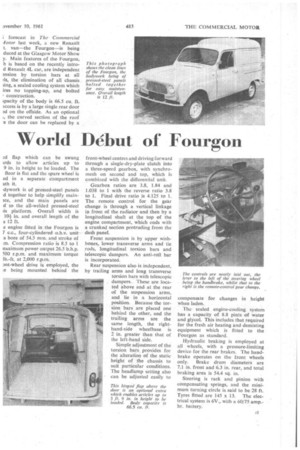World Debut of Fourgon
Page 127

If you've noticed an error in this article please click here to report it so we can fix it.
; forecast in The Commercial 4otor last week, a new Renault t. van—the Fourgon—is being duced at the Glasgow Motor Show y. Main features of the Fourgon, h is based on the recently introd Renault 4L car, are independent ansion by torsion bars at all
the elimination of all chassis dng, a sealed cooling system which ires no topping-up, and bolted construction.
tpacity of the body is 66.5 Cu. ft. lccess is by a large single rear door ad on the offside. As an optional L, the curved section of the roof t the door can be replaced by a
flap which can be swung trds to allow articles up to 9 in. in height to be loaded. The floor is flat and the spare wheel is ed in a separate compartment ath it.
• dywork is of pressed-steel panels
d together to help simplify mainice, and the main panels are cl. to the all-welded pressed-steel is platform. Overall width is 101 in. and overall length of the
s 12 ft. • e engine fitted in the Fourgon is 7 c.c., four-cylindered o.h.v, unit a bore of 54.5 mm. and stroke of m. Compression ratio is 8.5 to 1 naximum power output 26.5 b.h.p. 500 r.p.m. and maximum torque lb.-ft, at 2,000 r.p.m.
ont-wheel drive is employed, the Le being mounted behind the front-wheel centres and driving forward through a single-dry-plate clutch into a three-speed gearbox, with synchromesh on second and top, which is combined with the differential unit.
Gearbox ratios are 3.8, 1.84 and 1.038 to 1 with the reverse ratio 3.8 to 1. Final drive ratio is 4.125 to 1. The remote control for the gear change is through a vertical linkage in front of the radiator and then by a longitudinal shaft at the top of the engine compartment, which ends with a cranked section protruding from the dash panel.
Front suspension is by upper wishbones, lower transverse arms and tie rods, longitudinal torsion bars and telescopic dampers. An anti-roll bar is incorporated.
Rear suspension also is independent, by trailing arms and long transverse torsion bars with telescopic dampers. These are located above and. at the rear of the suspension arms, and lie in a horizontal position. Because the torsion bars are placed one behind the other, and the
trailing arms are the same length, the right
hand-side wheelbase is 2 in. greater than that of the left-hand side.
Simple adjustment of the torsion bars provides for the alteration of the static height of the chassis to suit particular conditions. The headlamp setting also can be adjusted easily to compensate for changes in height when laden.
The sealed engine-cooling, system has a capacity of 8.8 pints of water and glycol. This includes that required for the fresh air heating and demisting equipment which is fitted to the Fourgon as standard.
Hydraulic braking is employed at all wheels, with a pressure-limiting device for the rear brakes. The hand brake operates on the front wheels only. Brake drum diameters are 7.1 in. front and 6.3 in. rear, and total braking area is 54.4 sq. in.
Steering is rack and pinion with compensating • springs, and the minimum turning circle is said to be 28 ft. Tyres fitted are 145 x 13. The electrical system is 6V., with a 60/75 amp.hr. battery.








































































































































































































































































